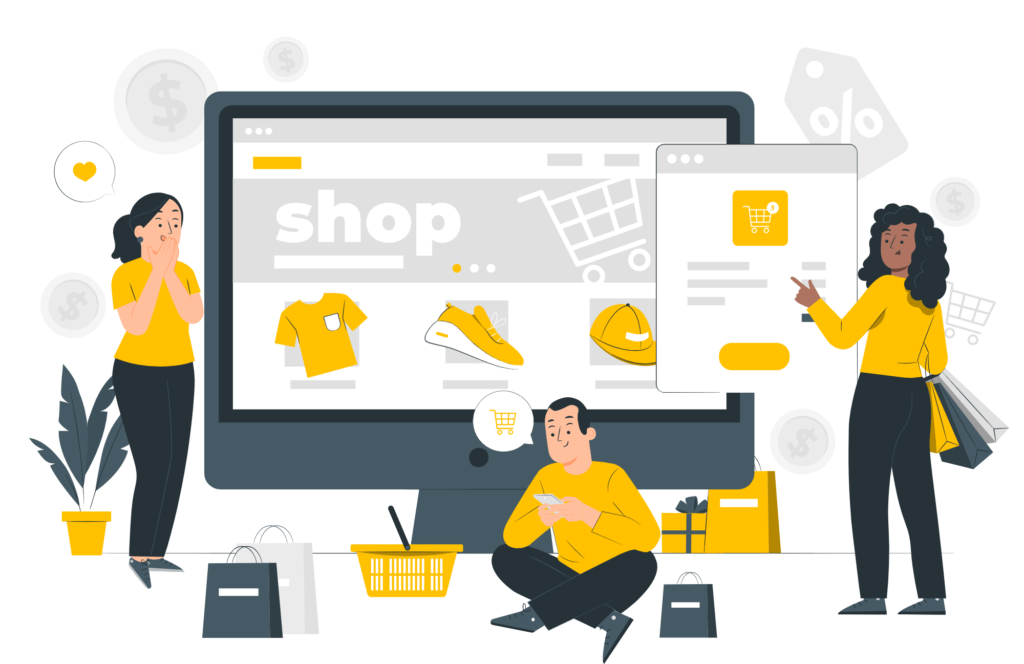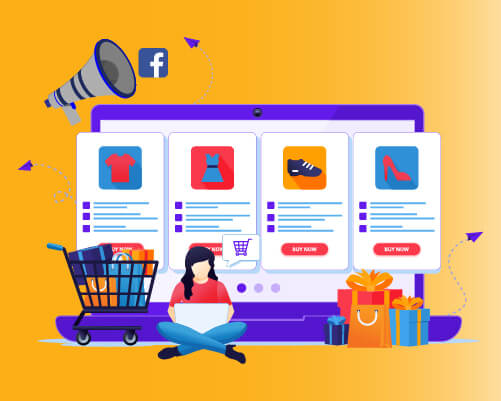Ecommerce has become the go-to shopping solution for consumers around the world. With more people turning to online shopping, it’s crucial for ecommerce businesses to have a strong marketing strategy in place. One effective way of promoting products and services is through ecommerce Facebook ads.
Facebook has over 2 billion active users, making it one of the largest social media platforms available. As such, it offers an excellent opportunity for ecommerce businesses to reach out to their target audience effectively. By utilizing Facebook ads, ecommerce companies can promote their products and services to potential customers, increase brand awareness, and drive sales. In this article, we will explore how ecommerce businesses can leverage Facebook ads marketing strategies to reach more customers and grow their business.
Table of Contents
Why Facebook ads matter for e-commerce?

Facebook ads play a significant role in the success of ecommerce businesses.
Here are some reasons why Facebook ads matter for ecommerce:
Targeted Advertising: Facebook provides robust targeting options based on demographics, interests, behaviors, and more. This allows ecommerce businesses to reach their ideal audience with precision. By targeting specific user segments likely to be interested in their products, businesses can increase the chances of driving relevant traffic and conversions.
Wide Reach: With over 2.8 billion monthly active users, Facebook offers access to a massive audience. Ecommerce businesses can tap into this vast user base and promote their products to potential customers across different age groups, regions, and interests. The platform’s reach enables businesses to scale their advertising efforts and increase brand visibility.
Retargeting Capabilities: Facebook’s retargeting options are particularly valuable for ecommerce. By using the Facebook Pixel or Custom Audiences, businesses can track user behavior on their website and create personalized ads for people who have previously interacted with their brands. This helps in re-engaging potential customers, reminding them of products they showed interest in, and increasing the likelihood of conversion.
Visual Appeal: Facebook is a highly visual platform, and ecommerce businesses can leverage this to showcase their products effectively. Through visually appealing ads, including high-quality images or videos, businesses can grab users’ attention and communicate the value and features of their products. Compelling visuals can significantly impact user engagement and drive more traffic to ecommerce websites.
Social Proof and Recommendations: Facebook ads allow businesses to incorporate social proof elements, such as reviews, ratings, or testimonials. By showcasing positive feedback from existing customers, ecommerce businesses can build trust and credibility, encouraging potential customers to make a purchase. Additionally, Facebook’s social nature allows users to share, comment on, or recommend products to their network, further amplifying the reach and impact of ads.
Analytics and Optimization: Facebook provides detailed analytics and reporting features that allow ecommerce businesses to track the performance of their ads. By analyzing metrics like reach, impressions, clicks, and conversions, businesses can gain valuable insights into the effectiveness of their campaigns. This data can then be used to optimize future ad strategies, refine targeting, and allocate budgets more efficiently.
Cost-Effectiveness: Facebook ads offer various budgeting options, making them accessible for businesses of all sizes. With careful targeting and optimization, ecommerce businesses can achieve a favorable return on investment (ROI) by reaching the right audience at a relatively lower cost compared to other advertising channels.
Overall, Facebook ads provide ecommerce businesses with a powerful platform to showcase their products, reach a wide audience, and drive targeted traffic to their online stores. By leveraging the platform’s features and optimizing campaigns based on data-driven insights, businesses can boost brand awareness, increase conversions, and ultimately achieve their ecommerce goals.
Examples of eCommerce Facebook Ads
Here are a few examples of eCommerce Facebook ads that you can use in your Ecommerce Facebook ads marketing campaigns.
Carousel Ad: This type of ad allows you to showcase multiple products or features in a single ad. Each image or video card can have its own headline, description, and call-to-action button. For example, a clothing brand could create a carousel ad featuring different outfits or accessories.
Collection Ad: Collection ads are designed to highlight a group of products from your eCommerce store. When a user clicks on the ad, they are taken to an immersive, full-screen experience that showcases the products. This type of ad is great for featuring a specific product line or a themed collection.
Dynamic Product Ad: Dynamic ads are personalized to each user based on their browsing behavior or past interactions with your website or app. For instance, if a user has viewed a particular product on your website, a dynamic ad can show that specific product along with similar or recommended items. This helps to retarget potential customers and increase conversions.
Video Ad: Video ads can be highly engaging and attention-grabbing. They can showcase your product in action, demonstrate its features, or tell a story related to your brand. Video ads are effective for building brand awareness and driving conversions. You can also experiment with different video formats like short, vertical videos for mobile users.
Offer Ad: An offer ad promotes a special deal or discount to entice users to make a purchase. It can be used to promote a limited-time sale, free shipping, or a percentage discount. The ad should clearly highlight the offer and provide a sense of urgency to encourage immediate action.
Testimonial Ad: Testimonials are powerful social proof that can build trust and credibility for your eCommerce store. You can create ads featuring customer reviews, ratings, or testimonials to showcase positive experiences and encourage others to make a purchase.
Remember, when creating Facebook ads for eCommerce, it’s essential to use high-quality visuals, compelling copy, and a clear call-to-action. You can experiment with different ad formats, targeting options, and ad placements to optimize your campaigns for better results.
how to Set up ecommerce Facebook Ads
Setting up ecommerce Facebook ads involves several steps to ensure a successful campaign.
Here’s a guide to help you get started:
- Define Your Advertising Goals: Determine your objectives for the campaign. Are you looking to increase brand awareness, drive website traffic, generate conversions, or boost sales? Clearly defining your goals will guide your campaign strategy.
- Set Up a Facebook Business Manager Account: Create a Facebook Business Manager account if you don’t already have one. This centralized platform allows you to manage your ad accounts, pages, and access various advertising tools.
- Create a Facebook Page: Set up a Facebook Page for your ecommerce business if you haven’t done so already. Your Page will serve as the foundation for running your ad campaigns and engaging with your audience.
- Install the Facebook Pixel: Install the Facebook Pixel on your ecommerce website. The Pixel is a snippet of code that tracks user interactions, conversions, and enables remarketing. It provides valuable data for optimizing your ads and measuring their effectiveness.
- Identify Your Target Audience: Determine your target audience based on demographics, interests, behaviors, and location. Understand who your ideal customers are to effectively reach and engage with them through your ads.
- Choose the Ad Objective: Select the appropriate ad objective that aligns with your campaign goals. Facebook offers a range of objectives, including brand awareness, reach, traffic, conversions, or sales. Choose the objective that best supports your desired outcome.
- Create Ad Sets: Ad sets allow you to define your audience targeting, budget, bidding strategy, and ad placements. Create multiple ad sets to test different targeting options, budgets, or strategies. This allows you to optimize your campaign based on performance.
- Develop Compelling Ad Creatives: Create visually appealing and engaging ad creatives that capture the attention of your audience. Use high-quality images or videos, compelling headlines, persuasive copy, and clear calls to action (CTAs) to encourage clicks and conversions.
- Set Up Ad Campaigns: Organize your ad sets and ad creatives into campaigns. Campaigns provide structure and help you manage your ads efficiently. Assign a unique name and budget to each campaign based on your overall strategy.
- Monitor and Optimize: Once your ads are live, monitor their performance regularly. Review key metrics such as impressions, reach, CTR, conversion rate, and ROAS. Make data-driven optimizations, such as adjusting budgets, targeting, or creatives, to improve performance.
- Track and Analyze Results: Utilize Facebook Ads Manager or other analytics tools to track and analyze the results of your campaigns. Understand which ads are performing well and driving desired actions. Use the insights gained to refine your strategies and optimize future campaigns.
- Test and Iterate: Continuously test different elements of your campaigns, such as ad creatives, audience targeting, or bidding strategies. A/B test variations to identify the most effective combinations. Learn from the data and iterate to improve your results over time.
Remember, setting up ecommerce Facebook ads requires ongoing monitoring, optimization, and refinement. Stay up to date with Facebook’s ad policies and best practices to ensure compliance and maximize the success of your campaigns.
Tracking and monitoring set up for ecommerce Facebook ads

To set up tracking and monitoring for your ecommerce Facebook ads, follow these steps:
- Install the Facebook Pixel: Install the Facebook Pixel on your ecommerce website. The Pixel is a snippet of code provided by Facebook that helps track user interactions, conversions, and other valuable data. It enables you to measure the effectiveness of your ads and optimize for specific actions.
- Set Up Event Tracking: Configure event tracking using the Facebook Pixel to track specific actions on your website, such as purchases, add to cart events, or sign-ups. This allows you to monitor the performance of your ads and optimize for conversions.
- Use UTM Parameters: Include UTM parameters in your ad URLs to track the source, medium, and campaign of your traffic in your website analytics tool (e.g., Google Analytics). This helps you attribute conversions and engagement back to your Facebook ads.
- Implement Conversion Tracking: Set up conversion tracking in Facebook Ads Manager to measure the success of your campaigns. Define the key actions you want users to take, such as purchases or sign-ups, and track them as conversions.
- Utilize Custom Conversions: Create custom conversions in Facebook Ads Manager to track specific actions on your website without modifying your website’s code. This allows you to track conversions based on specific URLs or events.
- Set Up Offline Events Tracking (if applicable): If you have a brick-and-mortar store or offline sales, consider using Facebook’s Offline Events feature to track and attribute offline conversions to your Facebook ads. This requires integrating your CRM or point-of-sale system with Facebook.
- Monitor Ad Performance: Regularly monitor the performance of your ads using Facebook Ads Manager. Track key metrics such as impressions, reach, click-through rate (CTR), conversion rate, and return on ad spend (ROAS). Analyze the data to identify trends, patterns, and areas for improvement.
- Set Up Automated Rules: Use Facebook’s automated rules feature to streamline your monitoring and optimization process. Set rules to automatically adjust budgets, bids, or targeting based on specific performance thresholds or objectives.
- Use Analytics Tools: Combine data from Facebook Ads Manager with data from other analytics tools, such as Google Analytics or third-party marketing platforms, to gain a holistic view of your campaign performance and user behavior.
- Continuously Optimize: Based on the data and insights gathered, make data-driven optimizations to your campaigns. Adjust targeting, bidding strategies, ad creatives, or landing pages to improve performance and maximize your return on investment (ROI).
Remember, tracking and monitoring your ecommerce Facebook ads is an ongoing process. Regularly review and analyze the data to make informed decisions and continuously optimize your campaigns for better results.
How to set up a catalog in Facebook ads for e-commerce
To set up a catalog in Facebook Ads for ecommerce, follow these steps:
- Prepare Your Product Data: Gather and organize the necessary product data for your catalog. This includes information such as product names, descriptions, images, prices, and other relevant attributes. Ensure your data is accurate and up to date.
- Create a Catalog Manager Account: Access Facebook Catalog Manager by visiting the Business Manager website (business.facebook.com) and navigating to the Catalogs section. Create a new Catalog Manager account if you don’t have one already.
- Choose Catalog Type: Select the appropriate catalog type for your ecommerce business. Facebook offers two types of catalogs: Ecommerce and Travel. Choose the Ecommerce catalog type for your ecommerce store.
- Add Product Feed: Upload your product data to create a product feed. A product feed is a file (typically in CSV or XML format) that contains all the information about your products. You can manually upload the feed or set up an automated feed that updates regularly.
- Map Product Attributes: Map the attributes in your product feed to the corresponding fields in the Facebook catalog. Ensure the attributes in your feed match the available fields in the catalog. Common attributes include ID, title, description, price, availability, image URL, and more.
- Set Up Product Sets: Product sets allow you to organize your products into specific groups for targeting and dynamic ad creation. Create product sets based on categories, collections, or any other segmentation that aligns with your advertising strategy.
- Enable Dynamic Ads (optional): If you want to run dynamic ads that automatically display relevant products based on user behavior and interests, enable the dynamic ads feature for your catalog. This allows you to create personalized ads at scale.
- Verify and Publish Your Catalog: Before you can use your catalog in ads, you need to verify and publish it. Facebook will review your catalog to ensure compliance with their policies. Once approved, your catalog is ready for use in ad campaigns.
- Set Up Pixel for Conversion Tracking (optional): If you haven’t already, install the Facebook Pixel on your ecommerce website to track conversions and events related to your catalog. The Pixel will provide valuable data for optimizing your campaigns and measuring their success.
- Use the Catalog in Ad Campaigns: Once your catalog is set up and published, you can use it in your ad campaigns. Create campaigns in Facebook Ads Manager, select the catalog as the product source, and choose the appropriate product sets for targeting or dynamic ad creation.
- Test and Optimize: Continuously monitor the performance of your catalog-based ad campaigns. Test different product sets, ad formats, targeting options, and messaging to optimize your campaigns for better results and higher conversions.
By setting up a catalog in Facebook Ads, you can leverage dynamic ads, retargeting, and personalized targeting options to showcase your products to the right audience, driving more engagement and conversions for your ecommerce business.
Must-Have Facebook events in Facebook ads for Ecommerce

In the context of ecommerce Facebook ads, there are several events that you can track and utilize for effective targeting and optimization. These events allow you to measure user actions and behaviors on your website or app, and leverage that data to enhance your ad campaigns.
Here are some key ecommerce events in Facebook ads:
- PageView: This event is triggered when a user visits a specific page on your website, such as a product page or category page. It provides insights into user interest and engagement with your products.
- ViewContent: This event is triggered when a user views specific content, such as a product, on your website. It helps track user engagement and interest in individual products.
- AddToCart: This event is triggered when a user adds a product to their shopping cart. It indicates strong purchase intent and is valuable for retargeting and creating dynamic product ads.
- InitiateCheckout: This event is triggered when a user initiates the checkout process by starting to enter their payment information. It signifies a higher level of purchase intent and can be used to target users who are close to completing a purchase.
- Purchase: This event is triggered when a user completes a purchase on your website. It provides data on completed conversions and allows you to track the revenue generated from your ads.
- Lead: This event is triggered when a user submits a lead form, such as signing up for a newsletter or requesting more information about your products. It helps measure lead generation and capture potential customer information.
- CompleteRegistration: This event is triggered when a user completes a registration process on your website, such as creating an account. It allows you to track new user sign-ups and registrations.
- Search: This event is triggered when a user performs a search on your website. It provides insights into user intent and the products or information they are actively seeking.
- Custom Events: You can also create custom events based on specific actions or events on your website that are relevant to your ecommerce business. For example, you can track events like “WishlistAdd” or “ReviewSubmission” to gain deeper insights into user behavior.
By tracking these ecommerce events in Facebook ads, you can create more targeted and personalized ad campaigns. You can use the data to retarget users who have shown specific behaviors or interests, optimize your ad delivery, and measure the effectiveness of your campaigns in driving conversions and revenue.
Targeting options for eCommerce Facebook ads

Facebook offers a wide range of targeting options for ecommerce businesses to ensure their ads reach the most relevant audience.
Here are some key targeting options available:
- Demographics: You can target users based on demographic characteristics such as age, gender, location, language, education level, relationship status, and more. This helps you tailor your ads to specific segments of your target market.
- Interests and Hobbies: Facebook allows you to target users based on their interests, hobbies, and activities. These interests can be general categories (e.g., fashion, fitness, technology) or specific topics (e.g., yoga, hiking, smartphones). By selecting relevant interests, you can reach users who are likely to be interested in your products.
- Behaviors: Facebook provides targeting options based on user behaviors, which include purchase behavior, device usage, travel preferences, and more. For ecommerce businesses, targeting users who have shown specific purchase behaviors, such as frequent online shoppers or recent purchases, can be highly effective.
- Custom Audiences: You can create custom audiences using your existing customer data, such as email addresses, phone numbers, or website visitors. By uploading this data to Facebook, you can target those specific individuals with your ads. This approach is particularly useful for retargeting campaigns, as you can re-engage potential customers who have already shown interest in your products.
- Lookalike Audiences: Facebook allows you to create lookalike audiences based on your existing customer base or website visitors. Lookalike audiences are new users who share similar characteristics and behaviors with your existing customers. This targeting option helps you expand your reach to a broader audience that is likely to be interested in your products.
- Connections: You can target users based on their connection to your Facebook Page, events, or apps. For example, you can show ads to people who have liked your Page or users who have engaged with your app. This targeting option enables you to reach users who have already shown some level of interest in your brand.
- Detailed Targeting Expansion: Facebook’s detailed targeting expansion feature allows the platform to automatically expand your targeting beyond your selected options while still focusing on reaching people who are likely to be interested in your ads. This feature can help you discover additional relevant audiences and maximize your campaign’s reach.
It’s important to note that you can combine multiple targeting options to create a highly targeted audience for your ecommerce Facebook ads. The more specific and relevant your targeting, the higher the chances of reaching users who are likely to convert into customers, resulting in a more effective and efficient ad campaign.
How to reach your ideal customer in Ecommerce Facebook Ads?
Reaching your ideal customers through Ecommerce Facebook Ads involves a strategic approach that combines effective targeting, compelling ad content, and continuous optimization.
Here’s a step-by-step guide to help you reach your ideal customers:
- Define Your Ideal Customer: Start by clearly identifying and understanding your target audience. Create buyer personas that describe your ideal customers’ demographics, interests, behaviors, pain points, and motivations. This information will guide your targeting and messaging strategies.
- Utilize Facebook’s Targeting Options: Leverage Facebook’s extensive targeting options to reach your ideal customers. Select relevant criteria such as demographics, interests, behaviors, and connections. Combine multiple targeting options to narrow down your audience and increase relevance.
- Use Custom and Lookalike Audiences: Upload your customer database to create custom audiences. Target these audiences with specific messaging tailored to their needs and preferences. Additionally, use lookalike audiences to expand your reach to users who share similar characteristics with your existing customers.
- Set Clear Objectives: Determine the goals of your Facebook ad campaigns, whether it’s increasing brand awareness, driving website traffic, generating leads, or driving sales. Clear objectives will help you align your messaging, calls to action, and campaign structure to achieve your desired outcomes.
- Craft Compelling Ad Content: Create attention-grabbing and engaging ad content that speaks directly to your ideal customers. Use compelling visuals, concise and persuasive copy, and clear calls to action. Highlight the unique value propositions of your products or services and address the pain points or desires of your target audience.
- Implement Retargeting Strategies: Set up Facebook Pixel on your website to track user behavior and create custom audiences for retargeting. Show relevant ads to users who have visited your website or added products to their cart but haven’t made a purchase. Retargeting helps reinforce your brand message and increases the likelihood of conversions.
- Monitor and Optimize: Regularly monitor the performance of your Facebook ad campaigns. Analyze metrics such as reach, engagement, click-through rates, conversions, and return on ad spend (ROAS). Identify areas of improvement and make data-driven optimizations, including adjusting targeting options, ad creative, budget allocation, or bidding strategies.
- Test and Iterate: Conduct A/B testing to compare different ad variations, targeting options, or campaign strategies. Test different visuals, ad formats, headlines, and calls to action to identify what resonates best with your ideal customers. Use the insights gained from testing to refine your ad campaigns and maximize their effectiveness.
- Leverage Social Proof: Incorporate social proof elements such as customer reviews, ratings, or testimonials in your ad content. Positive feedback from existing customers can build trust and credibility, influencing your ideal customers’ purchase decisions.
- Continuously Learn and Adapt: Stay updated with the latest trends, features, and best practices in Facebook advertising. Keep learning from your campaigns, competitor analysis, and industry insights. Adapt your strategies as needed to align with the changing preferences and behaviors of your ideal customers.
Remember that reaching your ideal customer requires a combination of accurate targeting, compelling messaging, and continuous optimization. By refining your approach based on data and customer feedback, you can improve the effectiveness of your Ecommerce Facebook Ads and increase your chances of success.
Creative elements in ecommerce Facebook Ads
When creating ecommerce Facebook ads, incorporating compelling and attention-grabbing creative elements is essential to capture the interest of your target audience and drive engagement.
Here are some key creative elements to consider:
- Eye-Catching Visuals: Use high-quality, eye-catching images or videos that showcase your products in the best possible light. Visuals should be visually appealing, relevant, and aligned with your brand identity. Ensure that the images or videos are well-lit, properly framed, and highlight the unique features or benefits of your products.
- Product Demonstrations: Consider using videos or carousel ads to demonstrate how your products work or showcase different product variations. Showing your products in action can help potential customers understand their functionality and imagine themselves using them.
- Lifestyle Imagery: Depict your products in real-life situations or scenarios that resonate with your target audience. Lifestyle imagery helps create an emotional connection and allows customers to visualize how your products can fit into their lives. For example, if you sell fitness apparel, show people exercising or participating in activities while wearing your products.
- User-Generated Content (UGC): Incorporate UGC in your ads by featuring images or videos shared by your satisfied customers. UGC adds authenticity, social proof, and credibility to your ads. It also encourages engagement and builds trust among potential customers.
- Clear and Compelling Copy: Write concise and persuasive ad copy that clearly communicates the value and benefits of your products. Use attention-grabbing headlines and compelling calls to action (CTAs) to encourage users to take action. Focus on the unique selling points, discounts, promotions, or any other incentives that can entice customers to click through and make a purchase.
- Social Proof: Include customer reviews, testimonials, ratings, or endorsements in your ad creative. Social proof enhances trust and credibility, assuring potential customers that others have had positive experiences with your products. Incorporate quotes, ratings, or review snippets in your visuals or ad copy to highlight positive feedback.
- Offer and Promotion Highlights: If you’re running specific offers, discounts, or promotions, make sure to highlight them in your ads. Use visuals or text overlays to emphasize the savings or limited-time nature of the offer. This can create a sense of urgency and incentivize potential customers to take immediate action.
- Clear Branding: Ensure that your ads reflect your brand’s visual identity consistently. Use your brand logo, colors, fonts, and other brand elements to create a cohesive and recognizable presence. Consistent branding helps build brand awareness, recognition, and trust over time.
- Ad Format Variation: Experiment with different ad formats offered by Facebook, such as carousel ads, collection ads, or dynamic product ads. Each format has unique features that can showcase your products in different ways and provide a richer user experience. Test different formats to identify which ones resonate best with your target audience.
- Mobile Optimization: Optimize your ad creative for mobile devices, as the majority of Facebook users access the platform through mobile devices. Ensure that your visuals and ad copy are easy to view and read on smaller screens. Test your ads on various mobile devices to ensure a seamless and engaging experience.
Remember to continually analyze the performance of your ad creative and iterate based on the insights gained. By refining your creative elements, you can create impactful and effective ecommerce Facebook ads that drive engagement, clicks, and conversions.
Design and copy tips for ecommerce Facebook ads
Design and copy are crucial components of ecommerce Facebook ads that can significantly impact their effectiveness.
Here are some design and copy tips to create compelling and engaging ads:
- Design Tips: Keep it Clean and Simple: Avoid cluttered designs and keep the overall layout clean and easy to understand. Use ample white space and clear visual hierarchy to guide the viewer’s attention to the key elements of the ad.
- High-Quality Visuals: Use high-resolution images or videos that showcase your products in an appealing and professional manner. Ensure that the visuals are well-lit, properly framed, and accurately represent the product’s colors, textures, and features.
- Attention-Grabbing Headlines: Create catchy headlines that capture the viewer’s attention within the first few seconds. Use short, impactful phrases that convey the main benefit or value proposition of your product.
- Consistent Branding: Maintain consistent branding elements such as colors, fonts, and logo placement across your ad creatives. This helps build brand recognition and reinforces your brand identity in the minds of viewers.
- Clear Call to Action (CTA): Incorporate a clear and compelling CTA that directs viewers on the desired action, such as “Shop Now,” “Learn More,” or “Add to Cart.” Make the CTA visually prominent and use contrasting colors to make it stand out.
- Mobile-Friendly Design: Optimize your ad design for mobile devices since a significant portion of Facebook users access the platform through mobile. Ensure that the visuals and text are easily readable on smaller screens, and test your ads on various mobile devices to ensure a seamless experience.
- Copy Tips: Concise and Persuasive: Keep your ad copy concise and to the point. Highlight the main benefits, unique selling points, or solutions that your product offers. Use persuasive language to create a sense of urgency or exclusivity.
- Use Emotional Triggers: Tap into the emotions of your target audience by using compelling language that resonates with their needs and desires. Highlight how your product can solve a problem, make their life easier, or enhance their well-being.
- Highlight Key Features and Benefits: Clearly communicate the key features and benefits of your product. Focus on what sets it apart from competitors and how it can fulfill the needs or desires of your target audience.
- Personalize when Possible: Whenever relevant, use personalization techniques to make the ad copy more engaging. Address the viewer directly using “you” or “your,” and consider tailoring the copy to specific segments of your audience based on their preferences or behaviors.
- Social Proof and Testimonials: Incorporate customer reviews, testimonials, or ratings to add credibility and social proof. Highlight positive feedback or real-life experiences to build trust and show that others have had a positive experience with your products.
- Create a Sense of Urgency: Encourage viewers to take immediate action by creating a sense of urgency. Use phrases like “Limited time offer,” “While supplies last,” or “Sale ends soon” to motivate potential customers to act quickly.
- A/B Testing: Experiment with different variations of your ad copy to identify which ones resonate best with your target audience. Test different headlines, descriptions, or value propositions to determine what drives the highest engagement and conversions.
Remember, it’s crucial to align your design and copy with your target audience’s preferences and motivations. Regularly analyze the performance of your ads, gather feedback, and iterate based on the insights gained to optimize your creative elements and maximize the effectiveness of your ecommerce Facebook ads.
Ecommerce Facebook Ad formats
Facebook offers various ad formats specifically designed for ecommerce businesses to showcase their products effectively.
Here are some popular ad formats you can utilize for your ecommerce Facebook ads:
- Single Image Ads: This format consists of a single static image that captures the attention of your audience. You can showcase your products, lifestyle shots, or any visually appealing image relevant to your offerings. Single image ads are simple to create and can be highly effective when combined with compelling copy and a clear call to action.
- Carousel Ads: Carousel ads allow you to display multiple images or videos within a single ad unit. Each image or video can have its own headline, description, and call to action. Carousel ads are ideal for showcasing different product variations, highlighting various features, demonstrating a step-by-step process, or telling a sequential story.
- Collection Ads: Collection ads combine a cover image or video with multiple product images underneath. When users click on the ad, they are taken to an instant, fullscreen shopping experience within the Facebook app. Collection ads are immersive and provide a seamless browsing and shopping experience for users, making it easier for them to discover and purchase products.
- Slideshow Ads: Slideshow ads are lightweight video-like ads that use a series of static images or a combination of images and videos. You can create a slideshow with product images, lifestyle shots, or visually appealing graphics to convey your brand’s story or highlight key product features. Slideshow ads are cost-effective and can be effective for engaging users with limited bandwidth or slower internet connections.
- Dynamic Product Ads (DPA): Dynamic Product Ads allow you to automatically promote relevant products from your product catalog to users who have expressed interest or shown intent. By setting up the Facebook Pixel and product catalog, you can dynamically generate personalized ads that show the exact products users have viewed or added to their cart. DPAs help in retargeting and reminding users about products they are interested in, thus increasing the chances of conversion.
- Instant Experience (formerly Canvas): Instant Experience ads provide an immersive, full-screen experience that combines images, videos, carousels, and more to showcase your products or tell a brand story. Users can engage with the ad by swiping, tapping, or exploring different sections. Instant Experience ads can be highly engaging and interactive, offering a memorable experience to potential customers.
- Collection Ads with Instant Experience: This ad format combines the benefits of collection ads and instant experience ads. It allows users to browse through a collection of products in a grid-like layout within the Facebook app. When they click on a product, it expands to an instant experience, where users can view more details, make a purchase, or explore related products.
These ad formats provide ecommerce businesses with a range of options to showcase their products, engage users, and drive conversions. Consider your campaign objectives, target audience, and the nature of your products to choose the most suitable ad formats for your ecommerce Facebook ads.
Tracking and measuring success for ecommerce Facebook Ads
Tracking and measuring the success of your ecommerce Facebook Ads is crucial to assess the effectiveness of your campaigns and optimize your strategies.
Here are key steps to track and measure the success of your ecommerce Facebook Ads:
- Define Key Performance Indicators (KPIs): Determine the metrics that align with your campaign objectives and business goals. Common KPIs for ecommerce Facebook Ads include impressions, reach, click-through rate (CTR), conversion rate, return on ad spend (ROAS), cost per acquisition (CPA), and revenue generated. Set specific targets for each KPI to evaluate the success of your campaigns.
- Set Up Facebook Pixel: Install the Facebook Pixel on your website to track user interactions and conversions driven by your ads. The Pixel allows you to measure and optimize for specific actions, such as purchases, add-to-cart events, or sign-ups. It provides valuable data on user behavior and allows you to attribute conversions to your Facebook Ads accurately.
- Conversion Tracking: Use Facebook’s conversion tracking feature to monitor specific actions taken by users after interacting with your ads. Set up conversion events, such as purchases, newsletter sign-ups, or form submissions, and assign them a value based on their importance to your business. Conversion tracking provides insights into the effectiveness of your ads in driving desired actions.
- Analyze Facebook Ads Manager: Utilize Facebook Ads Manager to access detailed performance data for your campaigns. Monitor key metrics, such as impressions, reach, CTR, conversion rate, and ad spend. Analyze the performance of individual ads, ad sets, and campaigns to identify high-performing and underperforming assets.
- Split Testing: Conduct A/B testing to compare different elements of your ads, such as visuals, copy, headlines, CTAs, or targeting options. Test one variable at a time to identify which variations yield the best results. Split testing helps optimize your ads based on data-driven insights and improve overall performance.
- Track Revenue and ROI: Integrate your ecommerce platform or customer relationship management (CRM) system with Facebook Ads to track revenue generated from specific campaigns or ads. This allows you to measure the actual impact of your ads on your bottom line and calculate the ROI of your Facebook advertising efforts.
- Google Analytics Integration: Link your Facebook Ads account with Google Analytics to gain a holistic view of your website’s performance and track the complete customer journey. This integration provides additional data on user behavior, traffic sources, conversions, and the overall impact of your ads on your website’s performance.
- Custom Reports: Customize reports in Facebook Ads Manager or other analytics platforms to display the metrics and data that matter most to your business. Create dashboards to track the performance of your KPIs over time and identify trends or patterns that can guide your optimization strategies.
- Ongoing Optimization: Continuously monitor your ad performance, analyze the data, and make data-driven optimizations. Adjust your targeting options, ad creative, bidding strategies, or budget allocation based on the insights gained from tracking and measurement. Iteratively improve your campaigns to maximize their effectiveness and ROI.
Remember that tracking and measuring success for ecommerce Facebook Ads is an ongoing process.
Setting goals and analyzing results in Ecommerce Facebook ads
Setting goals and analyzing the results of your ecommerce Facebook ads is crucial for evaluating the effectiveness of your campaigns and optimizing your strategies.
Here are the key steps to set goals and analyze the results of your ecommerce Facebook ads:
Define Clear Goals: Start by clearly defining your goals and objectives for your Facebook ad campaigns. Your goals could include increasing brand awareness, driving website traffic, boosting conversions, or generating revenue. Make sure your goals are specific, measurable, attainable, relevant, and time-bound (SMART goals).
Establish Key Performance Indicators (KPIs): Identify the key metrics that align with your goals and will help you measure the success of your ecommerce Facebook ads. Common KPIs for ecommerce include impressions, reach, click-through rate (CTR), conversion rate, return on ad spend (ROAS), cost per acquisition (CPA), and revenue generated. Select the KPIs that are most relevant to your business objectives.
Set Baseline Metrics: Before launching your Facebook ad campaigns, establish baseline metrics for the KPIs you’ve selected. These baseline metrics will serve as a benchmark to compare against the results of your ad campaigns. It’s important to have a clear starting point for measurement and analysis.
Implement Tracking Mechanisms: Set up tracking mechanisms, such as the Facebook Pixel, conversion tracking, or integration with analytics tools like Google Analytics. These mechanisms will allow you to track user interactions, conversions, and revenue generated from your Facebook ads accurately. Ensure that your tracking mechanisms are correctly implemented and functioning properly.
Monitor and Analyze Campaign Performance: Regularly monitor the performance of your Facebook ad campaigns using Facebook Ads Manager or other analytics platforms. Pay attention to key metrics like impressions, reach, CTR, conversion rate, and ROAS. Analyze the data to identify trends, patterns, and areas of improvement.
Compare Against Baseline Metrics: Compare the performance of your Facebook ad campaigns against the baseline metrics you established earlier. Assess whether you’ve achieved improvements in the desired KPIs. Determine if your campaigns are on track to meet your goals or if adjustments are needed.
Conduct A/B Testing: Perform A/B testing by creating variations of your ads, such as different visuals, ad copy, CTAs, or targeting options. Test one variable at a time to identify which elements have the most significant impact on your desired outcomes. A/B testing helps optimize your ads based on data-driven insights and improves overall performance.
Iterative Optimization: Continuously optimize your Facebook ad campaigns based on the insights gained from monitoring and analysis. Adjust targeting options, ad creative, bidding strategies, or budget allocation to improve performance. Test and refine your campaigns to maximize their effectiveness and achieve your goals.
Evaluate Return on Investment (ROI): Assess the return on investment of your Facebook ad campaigns by comparing the revenue generated against the ad spend. Calculate the cost per acquisition (CPA) and ROAS to determine the effectiveness and efficiency of your campaigns. Adjust your strategies accordingly to maximize your ROI.
Learn and Iterate: Learn from your campaign results and apply the insights to future campaigns. Use the data to refine your targeting, messaging, and creative elements. Continuously iterate and optimize your Facebook ad strategies to drive better results over time.
Remember that analyzing results and setting goals is an ongoing process. Regularly review and assess the performance of your ecommerce Facebook ads, make data-driven optimizations, and refine your strategies to achieve your business objectives effectively.
How much do Ecommerce Facebook ads cost?
The cost of ecommerce Facebook ads can vary widely depending on several factors, including your target audience, ad objectives, competition, ad quality, and bidding strategies.
Here are some key aspects that influence the cost of ecommerce Facebook ads:
- Ad Auction: Facebook operates on an auction-based system, where advertisers compete for ad placements. The cost of your ads will depend on the demand for ad placements, the number of advertisers targeting similar audiences, and the bidding strategies employed.
- Audience Targeting: The size and specificity of your target audience can affect the cost of your ads. Highly targeted audiences with specific demographics, interests, or behaviors may have higher costs due to increased competition. Broader audiences can have lower costs but may have lower conversion rates.
- Ad Relevance and Quality: Facebook rewards ads that are relevant, engaging, and have a positive user experience. If your ads have high engagement rates and receive positive feedback, they are more likely to achieve lower costs and better ad placements. Relevance and quality play a role in Facebook’s ad ranking algorithm.
- Ad Objectives: The ad objective you choose for your ecommerce Facebook ads can impact their cost. Different objectives, such as brand awareness, reach, traffic, conversions, or sales, may have varying costs based on the level of competition and the value Facebook attributes to each objective.
- Bidding Strategies: Facebook offers different bidding strategies, including cost per click (CPC), cost per thousand impressions (CPM), or cost per acquisition (CPA). The bidding strategy you select can affect the cost of your ads. Choosing the appropriate bidding strategy that aligns with your goals and budget is crucial.
- Ad Format and Placement: The format and placement of your ads also impact their cost. Some ad formats, such as video ads or collection ads, may have higher production costs but can be more engaging. Ad placements within Facebook’s network, such as News Feed, Stories, or Audience Network, can have different costs based on demand and user engagement.
- Seasonality and Demand: The time of year, holidays, or specific events can influence ad costs. During peak shopping seasons or competitive periods, such as Black Friday or Christmas, ad costs may increase due to higher demand from advertisers.
It’s important to note that Facebook Ads operates on a bidding system, and costs are highly dynamic. The actual cost of ecommerce Facebook ads can vary significantly from one campaign to another and can be influenced by multiple factors. It’s recommended to set a budget, regularly monitor your ad performance, and adjust your strategies based on the results to maximize the return on your advertising investment.
How to budget for ecommerce Facebook ads?
Budgeting for ecommerce Facebook ads involves careful planning and allocation of funds to ensure an effective and efficient advertising campaign.
Here are some steps to help you budget for ecommerce Facebook ads:
- Define Your Advertising Goals: Clearly outline your objectives and goals for your ecommerce Facebook ad campaign. Are you looking to increase brand awareness, drive website traffic, generate conversions, or boost sales? Understanding your goals will help you allocate your budget effectively.
- Determine Your Target Audience: Identify your target audience and their characteristics, such as demographics, interests, behaviors, and location. This information will help you estimate the size of your audience and plan your budget accordingly.
- Research Average Industry Benchmarks: Conduct research or consult industry reports to gain insights into average advertising costs within your industry or niche. This information can provide a starting point for setting your budget and understanding industry trends.
- Consider Lifetime Customer Value (LCV): Evaluate the potential lifetime value of a customer for your ecommerce business. Understanding the revenue generated from each customer over their lifetime can help you determine how much you can allocate for customer acquisition through Facebook ads.
- Start with a Test Budget: If you’re new to Facebook advertising or launching a new campaign, consider starting with a test budget. Allocate a smaller portion of your overall advertising budget to test different ad formats, audiences, and strategies. This allows you to gather data, evaluate performance, and make informed decisions for scaling your campaign.
- Determine Cost-Per-Acquisition (CPA) Goals: Calculate your target cost per acquisition (CPA) or customer acquisition cost (CAC). This is the amount you are willing to spend on average to acquire a new customer. Consider your profit margins and the lifetime value of a customer when setting your CPA goals.
- Consider Ad Frequency and Duration: Determine the frequency at which you want your ads to be shown to your target audience and the duration of your campaign. Balancing the frequency and duration will impact the overall budget required for your ecommerce Facebook ads.
- Monitor and Optimize: Regularly monitor the performance of your ads and make data-driven optimizations to improve their effectiveness. Adjust your budget allocation based on the performance of different ad sets or campaigns. Increase the budget for high-performing ads and decrease or pause underperforming ones.
- Test and Scale: As you gather more data and gain insights into what works best for your ecommerce Facebook ads, gradually increase your budget to scale your successful campaigns. Test new audiences, ad formats, or strategies with additional budget while keeping a close eye on the performance metrics.
- Consider Long-Term and Seasonal Planning: Factor in long-term advertising strategies and seasonal promotions when budgeting for ecommerce Facebook ads. Allocate additional budget for peak seasons or specific campaigns aligned with seasonal trends or events.
Remember to continuously monitor and evaluate the performance of your ecommerce Facebook ads. Adjust your budget and strategies based on the insights gained from the data to maximize your advertising ROI and achieve your business objectives effectively.
How to optimize E-commerce Facebook ads campaign
Optimizing your ecommerce Facebook ad campaign is essential to maximize its effectiveness and achieve better results.
Here are some tips to help you optimize your campaign:
- Clearly Define Your Goals: Ensure your goals are specific, measurable, attainable, relevant, and time-bound (SMART). Having clear objectives will help guide your optimization efforts.
- Target the Right Audience: Continuously refine your audience targeting to reach the most relevant and valuable audience for your ecommerce business. Utilize Facebook’s targeting options, such as demographics, interests, behaviors, and custom audiences, to narrow down your audience and increase the chances of conversion.
- Test Different Ad Formats and Creatives: Experiment with various ad formats, such as single image ads, carousel ads, or video ads, to determine which ones resonate best with your audience. Test different ad creatives, including visuals, headlines, copy, and CTAs, to identify the most effective combinations.
- Implement A/B Testing: Conduct A/B testing by creating variations of your ads with one variable changed at a time. Test different elements such as visuals, ad copy, CTAs, audience targeting, or bidding strategies. Analyze the results to identify the best-performing elements and optimize your ads accordingly.
- Optimize Ad Copy and Creative: Ensure your ad copy and creative are compelling, engaging, and relevant to your target audience. Use persuasive language, highlight key benefits, and include clear calls to action (CTAs) to encourage users to take action.
- Monitor and Adjust Bidding Strategy: Regularly review and adjust your bidding strategy to optimize your ad delivery and cost efficiency. Experiment with different bidding options, such as cost per click (CPC), cost per thousand impressions (CPM), or cost per acquisition (CPA), to find the most effective approach for your campaign goals.
- Optimize Landing Pages: Ensure that the landing pages you direct users to from your ads are optimized for conversions. Make sure they are mobile-friendly, load quickly, and provide a seamless user experience. Use clear and persuasive messaging to guide users towards your desired actions.
- Leverage Retargeting: Implement retargeting strategies to re-engage users who have interacted with your website or shown interest in your products. Set up dynamic product ads (DPAs) to remind users of products they viewed or added to their cart, and incentivize them to complete the purchase.
- Analyze and Optimize Data: Regularly review the performance data of your ad campaigns using Facebook Ads Manager or other analytics tools. Analyze key metrics such as impressions, reach, CTR, conversion rate, and ROAS. Identify trends, patterns, and areas of improvement to make data-driven decisions.
- Iterate and Learn: Use the insights gained from your optimization efforts to iterate and improve your campaigns. Implement changes based on data-driven decisions and continuously test and refine your strategies to achieve better results over time.
Remember, optimization is an ongoing process. Continuously monitor and adjust your ecommerce Facebook ad campaigns based on performance data, audience feedback, and market trends. By refining your targeting, ad creatives, bidding strategies, and landing pages, you can improve the effectiveness and ROI of your campaigns.
Best practices for e-commerce facebook ads campaign
To run a successful ecommerce Facebook ads campaign, consider the following best practices:
- Set Clear and Measurable Goals: Define specific, measurable goals for your campaign, such as increasing sales by a certain percentage or acquiring a specific number of new customers. This will help you track your progress and measure the success of your ads.
- Understand Your Target Audience: Thoroughly research and understand your target audience’s demographics, interests, behaviors, and pain points. This will enable you to create highly targeted and relevant ad campaigns that resonate with your audience.
- Compelling Ad Creative: Create visually appealing and attention-grabbing ad creatives. Use high-quality images or videos that showcase your products, highlight key benefits, and include clear and concise messaging. A compelling and relevant creative is crucial for capturing the attention of your audience.
- Use Clear Calls to Action (CTAs): Include clear and compelling CTAs in your ad copy to guide users to take the desired action, such as “Shop Now,” “Learn More,” or “Sign Up.” The CTA should align with your campaign objective and clearly communicate the next step you want users to take.
- Test Different Ad Formats and Variations: Experiment with different ad formats, such as single image ads, carousel ads, video ads, or collection ads. Test different variations of your ad creatives, headlines, copy, and CTAs to identify what resonates best with your audience and drives higher engagement and conversions.
- Implement Dynamic Product Ads (DPAs): Utilize Facebook’s dynamic product ads to automatically show relevant products from your catalog to users who have expressed interest in them on your website or app. DPAs can help you retarget potential customers and increase conversions.
- Implement Retargeting and Lookalike Audiences: Set up retargeting campaigns to reach users who have interacted with your website or shown interest in your products. Use lookalike audiences to find new users who are similar to your existing customers. These strategies can improve ad performance and increase conversions.
- Optimize Landing Pages: Ensure your landing pages are optimized for conversions and provide a seamless user experience. Make sure they are mobile-friendly, load quickly, and align with the messaging and offer in your ads. A well-optimized landing page improves the chances of users completing desired actions.
- Track and Analyze Results: Regularly monitor the performance of your ads using Facebook Ads Manager or other analytics tools. Track key metrics such as reach, impressions, click-through rate (CTR), conversion rate, and return on ad spend (ROAS). Use the data to identify trends, make data-driven optimizations, and refine your campaign strategy.
- Continuously Test and Optimize: Never stop testing and optimizing your campaigns. Test different elements such as ad creatives, audiences, placements, bidding strategies, or ad schedules to identify the most effective combinations. Regularly analyze the results and make data-driven decisions to improve your campaign performance.
Remember to stay up to date with Facebook’s advertising policies, algorithm changes, and best practices. Keeping informed about industry trends and leveraging new features and tools can give you a competitive advantage in running successful ecommerce Facebook ad campaigns.
Want to run Ecommerce Facebook Ads?
RankON Technologies is one of the best digital marketing agencies in India. We offer complete social media marketing services that include Facebook marketing services, Instagram marketing services and SMO services to help brands build better online reputations and grow their sales.
Get in Touch!Check our Facebook PackagesVisit our Facebook marketing plans or check complete social media marketing packages to run a Facebook advertising campaign for your business now!
Ecommerce Facebook Ads FAQs
To get started, you need to set up a Facebook Business Manager account, create a Facebook Page for your ecommerce business, and set up an ad account. From there, you can create ad campaigns, define your target audience, and start running ads.
The Facebook Pixel is a snippet of code provided by Facebook that you place on your ecommerce website. It allows you to track user interactions, conversions, and other valuable data. The Pixel helps you measure the effectiveness of your ads, optimize for specific actions, and retarget users who have shown interest in your products.
Facebook provides a range of targeting options to reach your ideal customers. You can target based on demographics (age, gender, location), interests, behaviors, and even custom audiences. Utilize these targeting options to narrow down your audience and reach the people most likely to be interested in your products.
Facebook offers various ad formats for ecommerce, including single image ads, carousel ads (multiple images or products in a scrolling format), video ads, collection ads (showcasing multiple products in an immersive format), and dynamic product ads (automatically generated ads based on user behavior).
The cost of ecommerce Facebook ads can vary depending on factors such as your targeting, competition, industry, and ad quality. You have control over your budget and bidding strategy, allowing you to set a daily or lifetime budget and choose between cost per click (CPC), cost per thousand impressions (CPM), or other bidding options.
Facebook provides comprehensive analytics through Facebook Ads Manager, where you can track metrics such as reach, impressions, click-through rate (CTR), conversion rate, return on ad spend (ROAS), and more. You can also integrate third-party analytics tools, like Google Analytics, for a deeper analysis of your ad performance.
Some best practices include setting clear goals, understanding your target audience, creating compelling ad creatives, testing different variations, optimizing your landing pages, and continuously monitoring and analyzing your ad performance. It’s also important to stay updated on Facebook’s advertising policies and industry trends.
Optimization involves continuously testing and refining your ad campaigns. Test different audiences, ad creatives, placements, and bidding strategies. Monitor your key metrics and make data-driven decisions to improve your targeting, messaging, and overall campaign performance.












